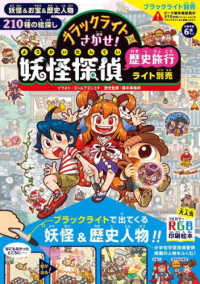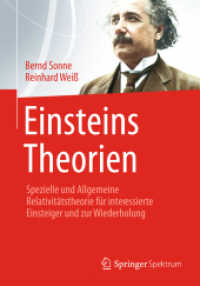- ホーム
- > 洋書
- > ドイツ書
- > Humanities, Arts & Music
- > Arts
- > general things about arts
Full Description
The book brings together the research completed during 10 editions of International Seminars of Bionics, organized by the School of Architecture of the University of Alcalá de Henares, Madrid, several of them in partnership with the "Ion Mincu" University of Architecture and Urbanism, Bucharest, carried out in Spain and in Romania. The articles here consider advanced bionic design principles, implementing them to an impressive variety of application fields, including, but not limited to, urban planning and landscape, public space, architecture and building structures, design and detailing, application of natural dynamic processes, bio-digital architecture, innovative materials based on living organisms (micro-algae), and nano-modified materials. A particular focus is given to light and perception of light. To illustrate the principles developed, this contributed volume includes descriptions and full-color images of the experimental projects created during the workshops held in the framework of these ISB meetings: Learning from Nature, Integrating Bionics (2009); Adaptability, Efficiency and Biostructures (2010); Bionics and Innovation (2011); Forms and Structures Inspired by Nature (2016, 2017); Furniture Inspired by Natural Models (2018); Relation between Structure and Envelope: Light Structures (2019); Light, from Nature to Architecture. Structures Inspired in Nature (2020); Light in Architecture and Design: A Bionic Perspective (2021); Sustainable Thinking and Bionics (2022).
Contents
PART 1: Learning from Natural Structures: the Basis for a Bionic Approach.- Chapter 1: Bio-Inspired Light Structural Systems: Micro-components of Nature.- Chapter 2: Bionics and the Future of Tall Building Design.- Chapter 3: FREI OTTO: LIGHT STRUCTURES INSPIRED BY NATURE EXPERIMENTS WITH PHYSICAL SELF-FORMING PROCESSES: SOAP SOLUTIONS, VISCOUS FLUIDS, BRANCHING STRUCTURES AND FUNICULAR FORMS.- Chapter 4: Categories of Natural Principles and their Adaptation to Bionic Design.- Chapter 5: The Bionic Paradigm of Light in Architecture and Design. From the Vision of Animals to Architectural Conception.- Part 2: Establishing the Tools: Parametric and Biodigital Architectural Design.- Chapter 6: Generative Bio-digital Architecture & Design.- Chapter 7: Bionic Architecture and the Cyborg Culture.- Chapter 8: The Potential of the Architectural Forms Derived from the Conoid.- Chapter 9: The Challenge of Next Generation Machine Learning Algorithms for Architecture Design and Living Environment.- Part 3: Studying Scales in Territory: Bionics and Landscape.- Chapter 10: Landscape as Process - A Crossdisciplinary Integrated Approach.- Chapter 11: Disruptive Biotop: Interstitial Space of Encounter between Architecture and the City.- Chapter 12: Life on Earth. Reflections in Moments of Crisis.- Chapter 13: Evolutionary Biophilic Concerns in the Landscape and the Relationship with the Future Society of Consciousness.- Chapter 14: Nature - a Structural Element of Future Human Settlements? Biophilic City Approaches - Today's Priority: Transition from Design to Urban Planning and Policy-making.- Chapter 15: Bionic Criteria for Sustainable Labelling of Buildings.- Part 4: Researching on Materials: from Macro to Nano.- Chapter 16: Micro-algae: the Industry of Future.- Chapter 17: Cultivating Micro-Algae in Architecture: Towards a Zero Carbon print .- Chapter 18: Nano-modified materials: Nano-Components for New Constructions and Technologies.- Chapter 19: PET Residual Recycled Concrete and Bacteria Encapsulation Method for Achieving Post-Fire Self-Healing Concrete.- Chapter 20: Adaptive and Bioinspired Materials: Cement-based materials with self-modulating and self-sensing properties.- Chapter 21: Practising Bionics: Experimental workshops.








